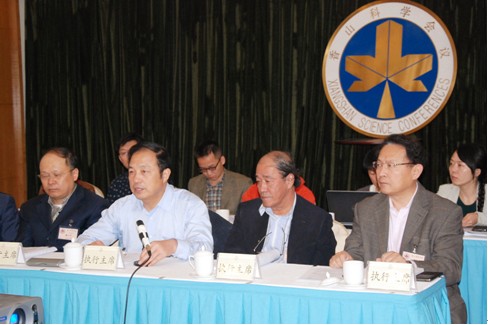Under the theme of Earth Observation for Cultural Heritage and Scientific Cognition, the 487th Session of the Xiang Shan Science Conferences (XSSC) took place at Xiang Shan Hotel in Beijing from April 2 to 4.
The meeting was co-chaired by RADI Director-general Prof. GUO Huadong, Prof. LIAO Xiaohan from the National Remote Sensing Center of China, Prof. ZHAO Hui from the School of Archaeology and Museology under Peking University and Prof. LIN Hui from the Chinese University of Hong Kong, bringing together more than 50 experts and scholars from China’s mainland, Hong Kong, Taiwan, and Sri Lanka and France.
Prof. Guo delivered a lecture entitled Mechanism behind Space-born Observation of Cultural Heritage and Scientific Cognition: Creating Space Archaeology. He reviewed the developments of space archaeology both at home and abroad, explained the mechanisms underlying space archeology from a variety of aspects, including optics, radar, GIS/GPS, virtual reality and the internet of things, and analyzed Earth observation capacities enjoyed by China and other countries, and showed typical cases of cultural heritage observation using space technology. On the basis of a bibliometrics-based analysis of the academic discipline and strength of cultural heritage and space-borne observation, he offered a suggestion on the academic framework of space archeology.
Furthermore, Prof. XU Bing, Prof. LIN Hui and Prof. ZHAO Hui gave reports on central topics of the meeting, respectively, theory and methodology for remote sensing detection of cultural heritages, environment reconstruction of cultural heritages and virtual geological environment, and significance of spatial structure of archeological remains and demand for its research and technology. In addition, 16 experts gave talks on various issues.
The conference is a get-together for senior, middle-aged and young scientists from academic fields and places, showing remarkable progress of space technology in cultural heritage since 2003 when the 216th session of the Xiang Shan Science Conferences was held under the theme of the space cognition of heritage information. This meeting clarified six priority fields of space archeology, including theory and methodology for space-borne observation of cultural heritages, and space technology for the detection, research and protection of cultural heritage; applicability studies of space archeology; space cognition of the impact of natural and anthropic activities on cultural heritages; reconstruction of cultural heritages and ancient environment and studies of man-land relations; and the connotation of space archeology and its research scope.
Participants called for establishing an academic system of space archeology after reaching a consensus on the interdisciplinary studies between space information technology and archeology.

A scene from the conference.

Executive co-chairs of the meeting.